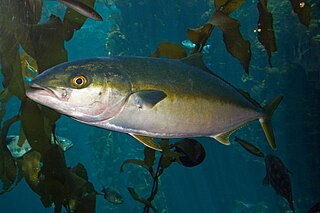
The yellowtail amberjack, yellowtail kingfish, hiramasa or great amberjack is a large fish found in the Southern Ocean. Although previously thought to be found in all oceans and seas, recent genetic analysis restricts S. lalandi proper to the Southern Hemisphere waters. However, they are found in Northern Hemisphere waters during certain times of the year. The fish was given its name by Monsieur de Lalande, a naturalist who first informed zoologist Achille Valenciennes of the existence of this species. His reason for the use of the word Seriola to name the fish is uncertain, but the second word lalandi was derived from his surname.

Hyporhamphus ihi, the known as the garfish, piper or by its Māori name takeke, is a halfbeak found all around New Zealand in shallow inshore waters.

The longfin boarfish, also known as the blackspot boarfish, is a species of marine ray-finned fish, an armourhead from the family Pentacerotidae which is native to the coasts of southern Australia, Tasmania and New Zealand. It can be found over the continental shelf and the continental slope at depths from 25 to 540 m. This species can reach a length of 40 cm (16 in). It can also be found in the aquarium trade, and is currently the only known member of the genus Zanclistius.

The Gulf wobbegong or banded wobbegong is a species of carpet shark in the family Orectolobidae, found in southern Australia between Southport, Queensland and Norwegian Bay, Western Australia.

The Dussumier's halfbeak, also known as the slender garfish, lives in reefs and shallow lagoons. It is an Indo-Pacific species which is found from the Seychelles east to the Tuamotu Islands, north to Hong Kong and Okinawa and south to northern Australia. They form schools which are found near the surface of lagoons and seaward reefs. The longest known specimen was 38.0 cm in length. This species was described by Achille Valenciennes in 1847 with the type locality given as the Seychelles. The specific name honours the French voyager and merchant Jean-Jacques Dussumier (1792-1883).

Hyporhamphus is a genus of halfbeaks. The species in this genus are distributed throughout the warmer seas of the world, most species being Indo-Pacific and there are some freshwater species.
Heteroclinus heptaeolus, or Ogilby's weedfish, is a species of clinid native to the coast of southern Australia where it can be found in habitats with plentiful seaweed growth. This species can reach a maximum length of 10 centimetres (3.9 in) TL.

Heteroclinus johnstoni, or Johnston's weedfish, is a species of clinid native to the waters along the around southern Australian coast where it prefers reefs with tall seaweed growth at depths down to about 50 metres (160 ft). This species can reach a maximum length of 40 centimetres (16 in) TL. The specific name honours the statistician and scientist Robert Mackenzie Johnston (1843-1918).
Heteroclinus macrophthalmus, the large-eye weedfish, is a species of clinid native to Indian Ocean waters around southern Australia where it prefers beds of sea-grass and algal reefs down to a depth of about 18 metres (59 ft). This species can reach a maximum length of 10 centimetres (3.9 in) TL.
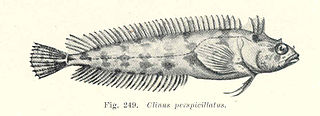
Heteroclinus perspicillatus, the common weedfish, is a species of clinid native to southern Australia where it is found in seagrass beds and rocky reefs at depths of up to 10 metres (33 ft). This species can reach a maximum length of 20 centimetres (7.9 in) TL.
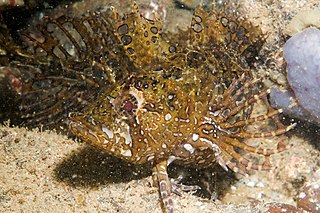
Heteroclinus tristis, the sharp-nose weedfish, is a species of clinid native to the coastal waters of southern Australia where it prefers sandy reefs with sparse vegetation. This species can reach a maximum length of 30 centimetres (12 in) TL. This species feed primarily fishes, shrimp and prawns.
Heteroclinus wilsoni, or Wilson's weedfish, is a species of clinid found along the coast of southern Australia and Tasmania where it can be found in weedy reefs from the intertidal zone down to a depth of about 20 metres (66 ft). This species can reach a maximum length of 14 centimetres (5.5 in) TL. The specific name honours John Bracebridge Wilson (1828-1895), a naturalist and headmaster who collected the type.
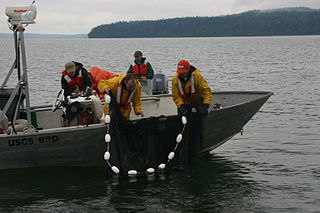
A lampara net is a type of fishing net. It is a surrounding net having the shape of a spoon or a dustpan with a short leadline under a longer floatline. The net has a central bunt to contain the fish and two lateral wings.
The black-tipped garfish or black-tipped halfbeak is a halfbeak from the family Hemiramphidae.
Hyporhamphus affinis, the tropical halfbeak, tropical garfish, insular halfbeak or coral reef halfbeak, is a species of schooling marine fish from the family Hemiramphidae. It is distributed through the Indo-Pacific regions and has been recorded in the Mediterranean Sea which it reached through the Suez Canal.

Vanacampus poecilolaemus, also known as the Australian long-nosed pipefish, is a species of marine fish belonging to the family Syngnathidae. They can be found inhabiting seaweed and seagrass beds of estuaries along the southern coast of Australia including the northern coast of Tasmania. Their diet likely consists of small crustaceans such as mysid shrimps. Adults of this species can reach up to 30 cm in length. Reproduction occurs through ovoviviparity in which the males brood eggs before giving live birth to roughly 40-50 offspring.
Hyporthodus septemfasciatus, the convict grouper, is a large species of grouper known from the waters of Japan, South Korea and China. Reports from western Australia are treated as misidentifications of Hyporthodus octofasciatus. This species is unique among the groupers that it can tolerate temperatures of down to 8°C (46.4°F) and can grow up to 155 cm and 62.8 kg. This reef-associated species is found at depths of 5-30 m and feeds on small fishes and crustaceans. In Japan, it is prized as a food fish and commercially cultured.
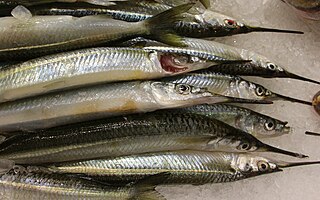
Hyporhamphus regularis is a halfbeak garfish from the family Hemiramphidae. It is found in Australian waters. The red tip on the lower jaw is an identification feature.

Hyporhamphus australis is a halfbeak garfish from the family Hemiramphidae. It is found in Australian waters. Also recorded at Lord Howe Island and Norfolk Island. The species involve in schooling as an adaptation method
Rhycherus gloveri, known as Glover's anglerfish, is a species of fish in the family Antennariidae. It is endemic to Australia, where it occurs in rocky reef environments on the country's southern and western coasts. It reaches 16 cm (6.3 in) in total length, and it differs from its close relative R. filamentosus in illicium length and escal morphology. It was named for Dr. C.J.M. Glover (1935-1992), a former ichthyologist of the South Australian Museum.














